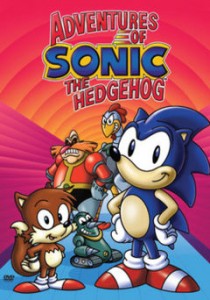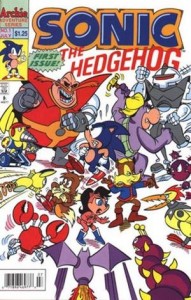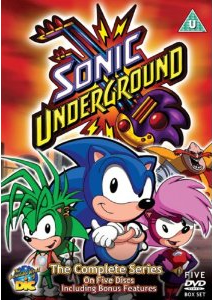In the eighties and early nineties, it was no secret that most if not all cartoons were made to sell toys. Nintendo had a head start against Sega in this half-hour animated commercial department with a slew of cartoon shows, most notably Super Mario Brothers and the Legend of Zelda while all the leftover characters were thrown into Captain N: The Game Master, featuring famous faces from several third party games as well. It was obvious that if Sega wanted to catch up in sales it would need to push itself into the hearts and minds of children with cartoons of its own.
Let us now travel back to the year 1993 and join the phenomenon that was Sonic The Hedgehog.
Adventures of Sonic The Hedgehog
 With Sonic, Sega finally had a character worthy of an animated series and in 1993, at the height of the company’s stardom after the release of arguably Sonic’s most successful title, Sonic The Hedgehog 2, the marketing machine’s gears began to turn. Targeting a younger audience, the Adventures of Sonic The Hedgehog premiered with a simple storyline that involved the evil Dr. Robotnik plotting to take over the planet Mobius. Unfortunately for “Robuttnik,” the spiny blue hedgehog who could run at the speed of sound and his two tailed flying-fox buddy Miles “Tails” Prower would always be there to get in the way. In every episode the wacky looking cartoon-ified version of Robotnik, who shared little resemblance to the Eggman of the 16-bit games, would dream up some hair-brained scheme and send his henchmen-bots, Scratch the rooster robot and Grounder the drill robot (both based loosely on minor enemies that can be found in Sonic 2), to try and finish off the pesky animals once and for all.
With Sonic, Sega finally had a character worthy of an animated series and in 1993, at the height of the company’s stardom after the release of arguably Sonic’s most successful title, Sonic The Hedgehog 2, the marketing machine’s gears began to turn. Targeting a younger audience, the Adventures of Sonic The Hedgehog premiered with a simple storyline that involved the evil Dr. Robotnik plotting to take over the planet Mobius. Unfortunately for “Robuttnik,” the spiny blue hedgehog who could run at the speed of sound and his two tailed flying-fox buddy Miles “Tails” Prower would always be there to get in the way. In every episode the wacky looking cartoon-ified version of Robotnik, who shared little resemblance to the Eggman of the 16-bit games, would dream up some hair-brained scheme and send his henchmen-bots, Scratch the rooster robot and Grounder the drill robot (both based loosely on minor enemies that can be found in Sonic 2), to try and finish off the pesky animals once and for all.
The show was mostly slapstick humor with more than a bit of Bugs Bunny thrown in. No matter how hard Robotnik and his goons tried, Sonic refused to be caught while he foiled them with his antics, comparable to Warner Brothers cartoons and at times even Ren and Stimpy. Ironically, Jaleel white of Family Matters Steve Urkel fame found himself playing the voice of Sonic. From super nerd to super cool, he would continue to be the voice most people in the west would associate as Sonic the Hedgehog for years to come. Although the show attempted to follow the video games in art style, Sonic’s invincibility theme from the game being used (as well as the show’s theme song), the games themselves had no real plot or character development at the time so the writers essentially created this poor man’s Looney Tunes. Still, the show was popular and can even still be seen occasionally on Toon Disney in the United States. It ran for a total of sixty-five episodes making it the longest running American Sonic cartoon. As a testament to its staying power, it returned for a one episode, a Christmas special, in 1996 titled Sonic Christmas Blast, named in obvious reference to the then recently released Sonic 3D Blast video game on the Sega Genesis and Saturn. Oddly enough this episode was a mix of the second American Sonic cartoon, featuring Princess Sally and Robotropolis creating further confusion for those who try to tie all of the different continuities together.
Sonic The Comic
Published in the UK by Fleetway Editions, Sonic the Comic started off as more of a Genesis (or in this case Mega Drive) comic than a Sonic one. Split into four different stories, the first one would always be a Sonic story, followed by three other stories featuring other famous Genesis games such as Shinobi, Streets of Rage, Shining Force and even Ecco the Dolphin, among others. Like the Archie Sonic and the Saturday morning cartoon, Sonic and his band of freedom fighters spent their days ruining the plans of the evil Dr. Ivo Robotnik. Sonic the Comic had some of its own original characters which were based on very early and unused concept work for the Saturday morning cartoon. One interesting feature of the comic was the Megadroid, the comic’s mascot, a robot comprised of parts from the Sega Mega Drive who would answer fan letters.
The comic also featured adaptations of the video games which most Sonic fans feel are more faithful than those found in Archie Comics. Besides the comics original characters it featured the essentials such as Tails, Knuckles, Amy, and even the Chaotix. The short stories based on other Genesis games not related to Sonic would disappear along with poor Megadroid in the comic’s post 16-bit era and they would soon be replaced by stories featuring the supporting characters of Sonic’s storyline instead. The letters section with Megadroid unfortunately remained missing-in-action for the remainder of the comic.
Sonic the Comic unfortunately met its demise in 2002 however thanks to an extremely loyal and active cult following the comic lives on in spirit in an unofficial fan continuation that can be found at STC Online.
Sonic the Hedgehog (Archie Comics)
The most expansive, longest running, and perhaps well-loved Sonic franchise outside of the video games themselves is Archie Comics’ Sonic The Hedgehog. It started innocently enough as a comic book tie in to promote both the Adventures of Sonic The Hedgehog cartoon series and the growing Genesis game library. After an initial miniseries, the comic was popular enough for a real run; however ABC was working on a new Sonic series at the time that would be more of an action/adventure show and steer away from the comedy. Archie decided to ultimately follow this formula and began making comics based on concept work for the new show causing the early issues to be a strange amalgamation of The Adventures of Sonic The Hedgehog and the new Sonic The Hedgehog Saturday morning cartoon. As the show premiered it took on a darker tone than expected and a few of the character concepts and names ended up being different than the original concepts, causing Archie Comics to make a few minor changes.
The comic would begin to chronicle the adventures of Sonic and his freedom fighter friends, forced to fight a guerrilla war for independence against the evil Dr. Robotnik who was far more sinister than his Adventures counterpart. This version of the madman had already taken over the planet Mobius by backstabbing the gullible King Acorn. Using a machine called the Roboticizer, developed for medical purposes by Sonic’s Uncle Chuck, Robotnik set out to turn the unsuspecting Mobians into mindless mechanical slaves.
 Archie Comics would also further the uniqueness of its creation by twisting the plots of the video games themselves into this already complex storyline, introducing characters that had never appeared on the television shows into the fray. On top of all of this Archie constantly threw out its own original stories and at times used its own brand of tongue-in-cheek humor left over from the Adventures days. The comic exploded with popularity, offering something for any Sonic fan to love thanks to this hybrid story telling. Several spin-offs and mini-series were produced and even within the main comic other characters were given as much attention and development as Sonic himself, including an uncountable amount of popular original characters created by Archie.
Archie Comics would also further the uniqueness of its creation by twisting the plots of the video games themselves into this already complex storyline, introducing characters that had never appeared on the television shows into the fray. On top of all of this Archie constantly threw out its own original stories and at times used its own brand of tongue-in-cheek humor left over from the Adventures days. The comic exploded with popularity, offering something for any Sonic fan to love thanks to this hybrid story telling. Several spin-offs and mini-series were produced and even within the main comic other characters were given as much attention and development as Sonic himself, including an uncountable amount of popular original characters created by Archie.
It’s easy to compare the Archie Sonic universe to Comic continuities such as Marvel and DC, as it’s grown to become a very vast and complex entity by itself. The comic continues to evolve and flourish today, long after the deaths of the cartoons that originally inspired it. The first major change that brought the comic into its modern version occurred with the defeat and death of Robotnik in the fiftieth issue so that he could return later as Sonic Adventure‘s Eggman, effectively bridging the gap from 16-bit to the new generation of Sonic games. Although comic book adaptations were made for the recent games inside of the Archie universe, like they had done for all of the 16-bit games, Archie has also launched an alternate universe title known as Sonic X, based on the anime series of the same name, leaving the main Sonic comic to spend more time focusing on its original stories, characters, and continuity.
Anyone who dares to be called a Sonic fan owes it to themselves to pick up an issue of this book to check it out.
Sonic The Hedgehog (Saturday Morning Cartoon)
Sonic’s action-adventure Saturday morning cartoon is generally considered by a majority of Sonic fans to be the best animated version of the blue speedster. This is mostly thanks to the successful Archie Comics line basing its characters and main storyline off of the ones featured in this series. Since the basic plot and characters are the same, I won’t bother reiterating them here.
Compared to The Adventures cartoon which was comical slapstick, the Saturday Morning outing would take a slightly darker turn as well as use the action/adventure genre. The story is comparable, though not identical to the one featured in archie comics. Being a televised cartoon, the envelope was not pushed quite as far as Archie Comics would end up pushing it in terms of storytelling. Some of the major differences between this cartoon and the Archie line is that many things that had been adopted from the games such as Chaos Emeralds and “Zones” were absent here, although the omnipresent “Rings” made an appearance and are vital to the plot in a few episodes.
To avoid confusion, most fans call this show “Sonic SatAM” because of its Saturday morning time slot. Although it’s perhaps the most popular Sonic animation, the series ran from only 1993 to 1995 for a total of two seasons and twenty-six episodes. A third season was apparently in the works; however it was aborted by the network. Some people contribute the show’s ratings failure its constantly changing air times, confusing the target audience of young viewers. Like the Archie Comics continuity, the cartoon retains a strong internet following and due to popular demand, a well deserved DVD release of the series is scheduled for 2007.
Sonic The Hedgehog: The Movie
Originally a two episode OVA (Original Video Animation) in Japan, the anime version of Sonic The Hedgehog was created in 1996 with an art style faithful to the video games, considering it used the same style of animation found in the opening and ending videos of the video game, Sonic CD. ADV films finally released the OVA as Sonic The Hedgehog: The Movie dubbed for the North American audience in 1999.
The storyline is pretty straight forward, which is understandable since it’s intended for kids. Dr. Eggman/Robotnik has kidnapped the President of South Island’s daughter and Sonic is called in to lend his heroics in rescuing the girl and putting a stop to Robotnik, who wants to marry her and destroy the world. Robotnik manages to program Metal Sonic, everyone’s favorite robot hedgehog copy with a bit of Sonic’s DNA to somehow make him The Blue Blur’s equal. The movie also includes other familiar faces such as Tails and the first animated version of Knuckles, who for some reason wears a cowboy hat and calls himself Sonic’s best friend instead of being his rival.
The movie is available on DVD and VHS and is worth watching if you’re a fan of the Sonic games, particularly Sonic CD. The animation is great and the storyline is comical enough to keep you entertained. It only makes me wish that Japan would’ve produced more 16-bit era Sonic cartoons.
Sonic Underground
Sonic Underground was the final cartoon that can be linked to the 16-bit era though more in aesthetics and tradition than the year it was made, which happened to be 1998, well after Sega had moved on to other things. The show revived the planet Mobius and the fight against Robotnik’s tyranny and even the “SatAM” art style. Jaleel White was back to voicing Sonic once again and Ben Hurst, a writer from “SatAM” was involved in the production. It seemed like Sonic Underground would be a dream come true for fans of the 1993 action/adventure series.
 Unfortunately, instead of a continuation of the earlier program, we were given an entirely new show. Sonic and his two newly introduced siblings, sister Sonia and brother Manic, were descendents of the planet’s royalty. Other than Robotnik and the appearance of Knuckles, no other characters from the video games would be included in the show’s cast. The storyline was somewhat similar to that of “SatAM” and the Archie Comics line in that the heroes were fighting an underground (hence the name I suppose) war of independence against Robotnik who had taken over Mobius by force. To help them in this task, the three hedgehogs had musical instruments with special powers and each episode featured a band performance by the siblings. Other recognizable terms and characters such as roboticization and Sonic’s Uncle Chuck would appear in the series and names like “freedom fighters” were also used though it’s important to note that there is no connection between the show and any other Sonic continuity (Sonic Underground does however, appear once in Sonic’s Archie Comic series as an alternate universe sort of thing).
Unfortunately, instead of a continuation of the earlier program, we were given an entirely new show. Sonic and his two newly introduced siblings, sister Sonia and brother Manic, were descendents of the planet’s royalty. Other than Robotnik and the appearance of Knuckles, no other characters from the video games would be included in the show’s cast. The storyline was somewhat similar to that of “SatAM” and the Archie Comics line in that the heroes were fighting an underground (hence the name I suppose) war of independence against Robotnik who had taken over Mobius by force. To help them in this task, the three hedgehogs had musical instruments with special powers and each episode featured a band performance by the siblings. Other recognizable terms and characters such as roboticization and Sonic’s Uncle Chuck would appear in the series and names like “freedom fighters” were also used though it’s important to note that there is no connection between the show and any other Sonic continuity (Sonic Underground does however, appear once in Sonic’s Archie Comic series as an alternate universe sort of thing).
Sonic Underground ran for only one season and although sixty-five episodes of the show were produced only forty of them ever saw release. The show is considered the least popular of Sonic’s animated offerings mainly because fans of “SatAM” and the Archie Comics continuity felt somewhat slighted by the change of characters and storyline. The show does have it’s own Internet following as well though it isn’t quite as massive or noteworthy.
Unfortunately, as the curtain closed on Sonic Underground, the chili dog-eating era of Sonic had come to a close. Sega would change everything by giving Sonic the Hedgehog an official story with the release of the character driven Dreamcast title, Sonic Adventure. Sega would then go on to produce more anime, such as the successful Sonic X based this new continuity.
A Diverse Legacy
Although Sonic now has his own official Sega canon of sorts, fans will always remember these early efforts to give the hedgehog hero an exciting back story, many of these efforts still living on today in the form of Archie Comics or even fan-made creations. They may have been made to push video game systems into our laps, but they’re forever stuck in our imaginations every time we fire up our Genesis or Mega Drive.

Recent Comments